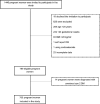Estimate of Dietary Total Antioxidant Capacity of Pregnant Women and Associated Factors
- PMID: 35213906
- PMCID: PMC9948131
- DOI: 10.1055/s-0041-1741454
Estimate of Dietary Total Antioxidant Capacity of Pregnant Women and Associated Factors
Abstract
Objective: To investigate the dietary total antioxidant capacity (DTAC) of pregnant women, and associated factors.
Methods: Cross-sectional study conducted with 785 pregnant adult women attended in primary health care centers of Ribeirão Preto, state of São Paulo, Brazil. Two 24-hour dietary recalls were obtained, and the usual intake was estimated through the Multiple Source Method. The DTAC was estimated using the ferric reducing antioxidant power assay. The relationship between the higher DTAC estimate (≥ median of 4.3 mmol/day) and associated factors was investigated using adjusted logistic models with backward selection.
Results: In total, 25% of the pregnant women were classified as overweight, and 32% as obese. The median (P25, P75) DTAC was 4.3 (3.3-5.6) mmol/day. Through adjusted logistic regression models with backward selection, a higher chance of DTAC estimates above the median among pregnant women aged ≥ 35 years old (2.01 [1.24-3.27]) was verified when compared with younger pregnant women. Women with prepregnancy overweight (0.63 [0.45-0.89]) and obesity (0.59 [0.40-0.88]) presented a lower chance of DTAC estimates above the median when compared with eutrophic pregnant women. A higher DTAC estimate was positively associated with the use of dietary supplements (1.39 [1.03-1.88]), and negatively associated with total dietary energy (0.59 [0.42-0.85]).
Conclusion: The DTAC estimate over the median was associated with greater age, adequate body weight, use of dietary supplements, and lower energy intake.
Investigar a capacidade antioxidante total da dieta (CATd) de gestantes e os fatores associados. MéTODOS: Estudo transversal conduzido entre 785 gestantes adultas em acompanhamento de pré-natal em Unidades Básicas de Saúde de Ribeirão Preto, São Paulo, Brasil. Para a estimativa da dieta usual, 2 inquéritos recordatórios de 24 horas foram obtidos e ajustados empregando-se o Multiple Source Method. A CATd foi estimada com base no ensaio de potência de redução de ferro. Para investigar a relação entre a maior estimativa de CATd (≥ mediana de 4,3 mmol/dia) e os fatores associados, foram empregados modelos de regressão logística ajustados em função backward. RESULTADOS: No total, 25% das gestantes foram classificadas com sobrepeso e 32% com obesidade. A mediana (P25; P75) da CATd foi de 4,3 (3,3–5,6) mmol/dia. Em modelos de regressão logística ajustados em função backward, verificou-se maior chance da estimativa da CATd acima da mediana entre gestantes com idade ≥ 35 anos (2,01 [1,24–3,27]), quando comparadas às gestantes de menor idade. Mulheres com sobrepeso (0,63 [0,45–0,89]) e obesidade (0,59 [0,40; 0,88]) no período pré-gestacional apresentaram menor chance da estimativa da CATd acima da mediana, quando comparadas às eutróficas. A estimativa da CATd foi positivamente associada ao uso de suplementos dietéticos (1,39 [1,03–1,88]) e negativamente associada à energia total da dieta (0,59 [0,42–0,85]). CONCLUSãO: A estimativa da CATd acima da mediana foi positivamente associada à maior idade, eutrofia, ao uso de suplementos dietéticos e à menor ingestão energética.
Federação Brasileira de Ginecologia e Obstetrícia. This is an open access article published by Thieme under the terms of the Creative Commons Attribution License, permitting unrestricted use, distribution, and reproduction so long as the original work is properly cited. (https://creativecommons.org/licenses/by/4.0/).
Conflict of interest statement
The authors have no conflict of interests to declare.
Figures
Similar articles
-
Factors associated with the dietary total antioxidant capacity of pregnant Brazilian women.Rev Bras Epidemiol. 2025 Feb 10;28:e250002. doi: 10.1590/1980-549720250002. eCollection 2025. Rev Bras Epidemiol. 2025. PMID: 39936734 Free PMC article.
-
Influence of dietary total antioxidant capacity on the association between smoking and hypertension in Brazilian graduates (CUME project).Nutr Metab Cardiovasc Dis. 2021 Aug 26;31(9):2628-2636. doi: 10.1016/j.numecd.2021.05.025. Epub 2021 Jul 3. Nutr Metab Cardiovasc Dis. 2021. PMID: 34229919
-
Dietary total antioxidant capacity is inversely related to menopausal symptoms: a cross-sectional study among Iranian postmenopausal women.Nutrition. 2018 Nov;55-56:161-167. doi: 10.1016/j.nut.2018.04.014. Epub 2018 Jun 7. Nutrition. 2018. PMID: 30086485
-
Dietary Total Antioxidant Capacity and Cardiovascular Disease Risk Factors: A Systematic Review of Observational Studies.J Am Coll Nutr. 2018 Aug;37(6):533-545. doi: 10.1080/07315724.2018.1441079. Epub 2018 May 1. J Am Coll Nutr. 2018. PMID: 29714643
-
Dietary total antioxidant capacity and mortality from all causes, cardiovascular disease and cancer: a systematic review and dose-response meta-analysis of prospective cohort studies.Eur J Nutr. 2019 Sep;58(6):2175-2189. doi: 10.1007/s00394-019-01922-9. Epub 2019 Feb 11. Eur J Nutr. 2019. PMID: 30756144
Cited by
-
Factors associated with the dietary total antioxidant capacity of pregnant Brazilian women.Rev Bras Epidemiol. 2025 Feb 10;28:e250002. doi: 10.1590/1980-549720250002. eCollection 2025. Rev Bras Epidemiol. 2025. PMID: 39936734 Free PMC article.
References
-
- Kibret K T, Chojenta C, Gresham E, Tegegne T K, Loxton D. Maternal dietary patterns and risk of adverse pregnancy (hypertensive disorders of pregnancy and gestational diabetes mellitus) and birth (preterm birth and low birth weight) outcomes: a systematic review and meta-analysis. Public Health Nutr. 2018;22(03):1–15. doi: 10.1017/S1368980018002616. - DOI - PMC - PubMed
-
- Jamilian M, Mirhosseini N, Eslahi M, Bahmani F, Shokrpour M, Chamani M. The effects of magnesium-zinc-calcium-vitamin D co-supplementation on biomarkers of inflammation, oxidative stress and pregnancy outcomes in gestational diabetes. BMC Pregnancy Childbirth. 2019;19(01):107. doi: 10.1186/s12884-019-2258-y. - DOI - PMC - PubMed
MeSH terms
Substances
LinkOut - more resources
Full Text Sources
Medical
Research Materials


